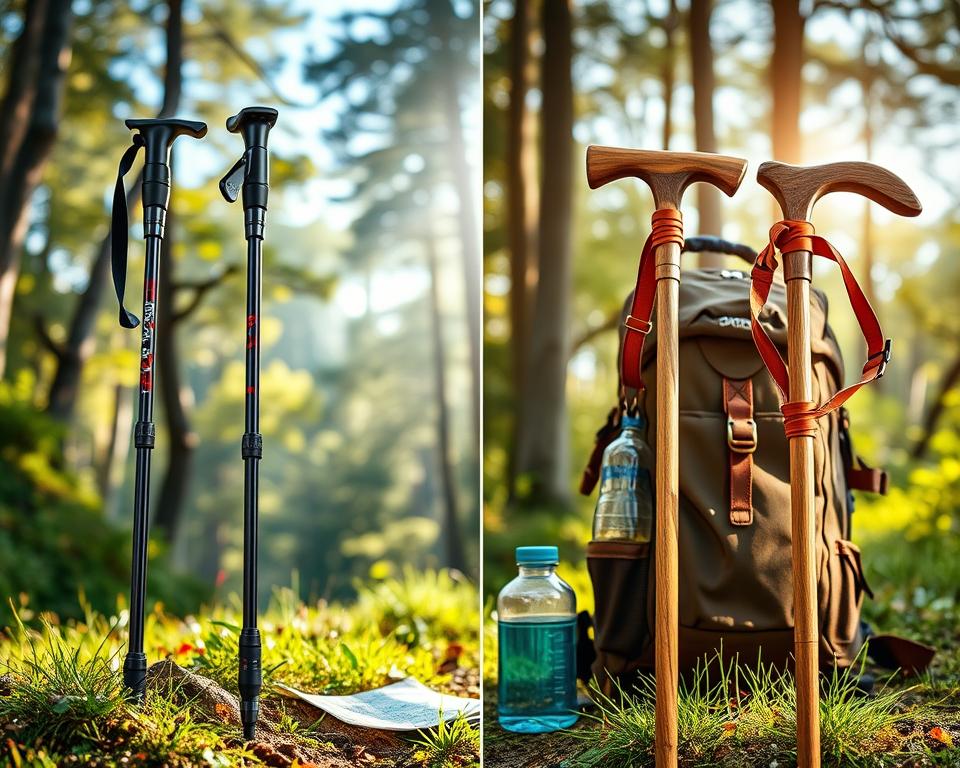Choosing between trekking poles and hiking sticks can be tricky. Each has unique benefits for different hiking needs. We will explore trekking pole advantages and hiking staff benefits. This will help you pick the right gear in this hiking gear comparison.
Trekking poles, much like ski poles, are great for heavy backpacks or steep hikes. They can lessen knee strain by up to 25%, a big help on long treks. They adjust in length, absorb shocks, and have comfy grips, which make them good for many trails.
Hiking sticks are different as they are usually used alone, offering a simpler way to connect with nature. They’re perfect for hikers who prefer less gear. With a hiking stick, you don’t waste time attaching it to your backpack like you would with trekking poles.
Your choice depends on your preference and the hike itself. Trekking poles are best for tough or snowy paths, giving more stability. But, if you like easy walks and carrying less, a hiking stick is ideal.
Next, I will talk about each option’s specific benefits. This will help you see which is better for your adventures.
Benefits of Using Trekking Poles
Trekking poles offer several benefits for hikers, improving safety, balance, and the whole hiking experience. They are great for tough terrains, crossing streams, slippery conditions, and for a full-body exercise. Trekking poles are a must-have for outdoor adventures.
Enhanced Stability and Support
Trekking poles give amazing stability and support. They are super helpful for those with heavy packs or walking on rough paths. These poles help keep your balance.
Research shows they spread your weight more evenly. This means less stress on your knees and ankles. They’re a big help for folks with joint issues.
Stream Crossings and Testing Depth
When it comes to stream crossings, trekking poles are super useful. They let you check the water’s depth and the steadiness of rocks below. This can prevent slipping and falling, making crossing safer.
They help spot hidden dangers in the water. This makes getting across streams less scary.
Winter Hiking and Slippery Conditions
Trekking poles aren’t just for summer. They’re really helpful in winter too. Snow and ice make hiking tough, but poles can improve grip.
They also help keep you upright, making it easier to walk on icy paths.
Full Body Workout
Using trekking poles turns hikes into full-body exercises. They work out your arms, shoulders, and chest. This spreads out the effort you use.
Studies say this can burn 20 percent more calories. Plus, it keeps your arms up, reducing swelling and bettering circulation. This makes trekking poles great for both fitness and hiking.
Trekking poles have many uses, making them a key part of your hiking gear. They not only increase stability but also offer a good workout. For even more information, check out this detailed guide on trekking poles.
When to Choose Hiking Sticks
Choosing a hiking stick can make your hikes better, especially for fans of simple hiking. We will look at when a single hiking staff is the perfect choice.
Single Staff for Casual Walks
If you like easy walks in nature, a single hiking staff is great. It helps just enough without being too much. A single staff makes your walks simpler and more fun.
Less Gear, More Connection with Nature
A single hiking staff is perfect for minimalist hiking. It allows you to connect more with nature. With fewer things to carry, you can really enjoy the beauty around you.
Situations Where Minimalism is Preferred
Some hiking times call for carrying less. Minimalist hiking means less weight and more focus. A single staff helps you tire less and enjoy long hikes more.
Key Features of Trekking Poles
Quality trekking poles enhance your hiking. They include different materials, adjustable lengths, and shock absorption. This makes your hike better.
Materials: Aluminum vs. Carbon Fiber
When picking hiking pole materials, you’ll see aluminum and carbon fiber. Aluminum ones are tough and good for rough paths. Carbon fiber poles are lighter, making hikes less tiring but can break easier in harsh conditions.
Adjustability and Locking Mechanisms
Adjustable trekking poles let hikers change the length for different trails. Locks like flick-lock levers and twist locks keep poles fixed at your chosen length. The Leki Super Micro Trekking Pole, for example, folds down to 18 inches, perfect for traveling.
Shock Absorption and Grip Types
Shock-absorbing sticks protect your knees on downhill walks. The Leki Sierra SAS has a soft anti-shock system to ease ground impact. There are also different grips. Cork grips handle sweat well and feel comfy. Foam grips, like on the Leki Sierra SAS pole, prevent hand fatigue during long hikes.
Trekking poles are loved by day and long-distance hikers. They come with features like the right hiking pole materials and adjustable trekking poles. They also have shock absorption. These features give you support, stability, and comfort on your hikes.
Best Practices for Using Trekking Poles and Hiking Sticks
Learning to hike right can make your outdoor trips better. Trekking poles help shift about 20% of your weight off your legs. This eases the strain on your knees and back, making hikes comfier, especially the long ones.

Trekking poles and hiking sticks need to fit well. They should match both the user’s height and the trail’s demands. The Gossamer Gear LT5 poles, for example, adjust from 41 to 51 inches. This suits a range of heights and paths. Besides, carbon fiber makes them light yet strong, cutting down trail vibrations.
Using trekking poles right is key when facing streams or steep areas. The right grip and step pattern keep away blisters and tiredness. This makes your hike more enjoyable. The Gossamer Gear LT5 poles have comfy, water-resistant EVA foam grips. They’re great for long walks.
Trekking poles make hiking a workout for your whole body. Nordic walking ups your calorie burn. So, you get a harder workout. This means better health benefits from your hiking trips.
Choosing the right pole matters too. 70% of hikers use two poles for faster uphill moves, stability downhill, and joint care. Yet, 30% pick one pole for its lower cost and ease of carry. For those with joint issues like osteoarthritis, poles can ease joint pressure and help with balance.
Practice with your poles before hitting tough trails. This makes you more comfy and sure on your feet. Good prep leads to smoother walks and steadier footing. That means safer, more fun hiking experiences.
Trekking Poles vs. Hiking Sticks: Which is Right for You?
Choosing the right hiking gear means knowing the difference between trekking poles and hiking sticks. If you’re trying to decide, think about the trail, what you like, and how heavy your backpack is. These factors will help you pick the right gear for your hike.
Terrain and Hiking Conditions
Terrain and hiking conditions are key in choosing your equipment. Trekking poles are great for tough, uneven trails and crossing streams. They provide extra stability and balance. This is especially true in winter, helping you on snowy and slippery paths.
For easier, smooth trails, hiking sticks are a good pick. They offer a simpler way to enjoy your hike. So the gear you choose depends a lot on where you’ll be walking.
Personal Preference and Hiking Style
What you like and how you hike matter a lot in deciding on gear. Trekking poles, which come in pairs, are for those wanting more support and workout. They also ease up to 25% of the strain on your knees.
Hiking sticks, usually just one, are for those who like to keep it simple. Your gear choice often depends on how much stuff you want to carry. So, think about what feels right for you.
Load and Backpack Weight Considerations
Your backpack’s weight is another important factor. Trekking poles are helpful with heavier loads. They support your arms, helping prevent tiredness. They can also prop up ultralight shelters.
If your backpack is light or you’re just out for an easy walk, a hiking stick might be enough. It’s practical and not too much to carry. So the decision also depends on how much you’re packing.
Can a Trekking Pole or Hiking Stick Be Used to Carry a Solar Charger or Power Bank While Hiking?
Using trekking poles or hiking sticks can be a smart way to carry essential gear. When secured properly, solar chargers or power banks for hiking can be attached to your pole. This setup frees your hands while ensuring you have power available to keep devices charged during longer treks.
Conclusion
When you think about trekking poles and hiking sticks, the key is knowing what you need. Your choice depends on your activities and the places you plan to explore. Trekking poles are great for people with arthritis or those carrying a lot of weight. They provide stability and support, making it easier to walk and relieving pressure on your legs.
Studies show that trekking poles can lessen the chance of injuries like ankle fractures. They help you keep balance and support a proper posture when carrying things. If you’re over 50 or have joint pain, trekking poles can make hiking more enjoyable and less painful.
Hiking sticks are for those who like to keep things simple. They are good for easy walks and help you feel closer to nature. Hiking sticks are less about features and more about enjoying a lighter way to hike.
Both trekking poles and hiking sticks have their benefits. It all comes down to what you prefer, how you hike, and where you go. This guide is here to help you decide, so your hiking trips are safe and fun. Keep these tips in mind to choose the right gear for your adventures.

